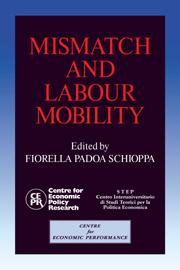Book contents
- Frontmatter
- Contents
- List of figures
- List of tables
- Preface
- Acknowledgements
- List of conference participants
- 1 A cross-country comparison of sectoral mismatch in the 1980s
- 2 Mismatch: a framework for thought
- Discussion
- 3 Match and mismatch on the German labour market
- Discussion
- 4 Mismatch in Japan
- Discussion
- 5 Mismatch and internal migration in Spain, 1962–86
- Discussion
- 6 Regional inequalities, migration and mismatch in Italy, 1960–86
- Discussion
- 7 Skill shortages and structural unemployment in Britain: a (mis)matching approach
- Discussion
- 8 Labour market tightness and the mismatch between demand and supply of less-educated young men in the United States in the 1980s
- Discussion
- 9 Skill mismatch, training systems and equilibrium unemployment: a comparative institutional analysis
- Discussion
- 10 Unemployment, vacancies and labour market programmes: Swedish evidence
- Discussion
- 11 Mismatch and labour mobility: some final remarks
- Index
Discussion
Published online by Cambridge University Press: 05 October 2010
- Frontmatter
- Contents
- List of figures
- List of tables
- Preface
- Acknowledgements
- List of conference participants
- 1 A cross-country comparison of sectoral mismatch in the 1980s
- 2 Mismatch: a framework for thought
- Discussion
- 3 Match and mismatch on the German labour market
- Discussion
- 4 Mismatch in Japan
- Discussion
- 5 Mismatch and internal migration in Spain, 1962–86
- Discussion
- 6 Regional inequalities, migration and mismatch in Italy, 1960–86
- Discussion
- 7 Skill shortages and structural unemployment in Britain: a (mis)matching approach
- Discussion
- 8 Labour market tightness and the mismatch between demand and supply of less-educated young men in the United States in the 1980s
- Discussion
- 9 Skill mismatch, training systems and equilibrium unemployment: a comparative institutional analysis
- Discussion
- 10 Unemployment, vacancies and labour market programmes: Swedish evidence
- Discussion
- 11 Mismatch and labour mobility: some final remarks
- Index
Summary
Relatively high growth rates have made it difficult to explain the recent high European unemployment rates within the usual business cycle framework. Mismatch is an interesting alternative hypothesis. This study sets forth an inclusive definition of mismatch unemployment, estimates its importance from historical data, and examines its public policy implications. The authors conclude that mismatch may account for a large share of total unemployment, but not for the recent increase in the unemployment rate.
Most economists probably would define ‘mismatch’ as a state in which jobs and workers are located in different places; such conditions rise from unanticipated shifts in the composition of demand or in technology due to such things as trade liberalisation, deregulation and privatisation. Permanent changes set up a disequilibrium which cause labour and other resources to move higher-valued uses. Historical evidence suggests that these adjustments occur over lengthy periods of time: not only are there large marginal costs of adjustment, but substantial fixed costs imply that mobility decisions are conditioned on permanent rather than on temporary changes. It may take a long time for people to understand that the changes are indeed permanent; nonetheless, mobility works to move the economy towards an equilibrium allocation of resources.
Jackman, Layard and Savouri (hereafter JLS) take a rather different approach. They define mismatch, without reference to equilibrium or disequilibrium, as the variance in relative unemployment rates among occupational, education, industry and regional categories. However, the fact is that unemployment rates systematically differ among these categories on a more or less permanent basis.
- Type
- Chapter
- Information
- Mismatch and Labour Mobility , pp. 101 - 104Publisher: Cambridge University PressPrint publication year: 1991



